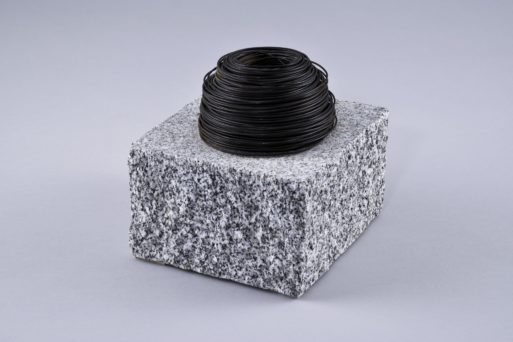Stone and Coil
There is a solid square jewelry box on an Osvaldo Borsani table in La Betty’s bedroom. The lower half of the box is wrapped in stone gray satin. The satin-wrapped lid is burnt umber.
If we imagine the bottom of the jewelry box as a cube of rough marble and the top of the box as a carefully wound coil of thick dark wire, we can review what a phantom psychoanalyst explained to La Betty. The psychoanalyst was intent upon tempting La Betty away from her obsession with advertising. He wanted her to concede to the theory of neurosis accounting for her obsession. He was enticing La Betty toward an acknowledgement of her embryonic Super-Ego, and he expected her to discover she was only pretending to ignore her Id.
First the psychoanalyst had stated, “Behind every neurosis is the fear of Death.” The psychoanalyst informed La Betty that the human mind dreads experiencing something utterly unprecedented. To this he had added that the human psyche is terrified by something against which it is entirely helpless. The mixture of these two absolutes instills a horror of the idea of Death when realistically no experience of actually being dead is possible.
La Betty hadn’t comprehended any of these psychoanalytic pronouncements and that is why it took her some time to recognize that the psychoanalyst was a miserable tempter, a phantom killjoy whose motives were hostile.
“Consider this rough-cut cube of marble,” the tempter continued, “It must be a symbol of death. See how it reminds one of something obdurate, something that neither negotiates nor cooperates. Intrinsic to the stone you will find no natural motive force, no transformative impulse. We must concede this marble cube is solid, heavy, and in a word inorganic. Allegorically this stone is as dispassionate as Death.”
The psychoanalyst proceeded to describe how Freud discovered the Death Instinct. Freud had been bewildered by his analysands who would not equate health with an increase in the Pleasure Principle. His analysands would behave in ways that made them weaker and more ineffective. What was this?
Late one night Freud found himself contemplating the fragment of a stone Egyptian obelisk from his collection of antiquities. Suddenly he grasped what exactly he had been pondering: there must be an inclination, a tendency, a drive in all living things to undo the Eros of living, a drive to undo what the Will had attained.
Without any knowledge of DNA, Freud conjectured that every living creature is born with an impetus to undo itself. As Freud examined the obelisk fragment he suddenly understood: yes, the obelisk was carved and inscribed with human significance, but it was in essence a lifeless, unknowing chunk of stone. Thus the Death Instinct was revealed! Like artful engraving on lifeless marble all living beings are elemental atoms and concatenated molecules. Inherently, underneath the allure of artful engraving a clump of molecules is the substrate for an uncivilized desire. The Death Drive oxidizes the organic component until we are once again a mesh of passive molecules, until we are once again stripped to the substrate. In our ordinary lives day after day the Death Drive is edging us toward the ultimate apathy: an inorganic state.
The phrase “inorganic state” alerted La Betty that she was being courted intellectually by an insidious entity. In the guise of psychoanalyst this entity, as does every invading entity, was trying to shake La Betty’s faith in the power of shopping. Although basically she had no comprehension of this Freudian logic, La Betty was repulsed by the idea of slumping into an inorganic state. This seemed like something not worth knowing, especially when La Betty had gathered for herself the ways, objects and supports to live undistracted by theories, hypotheses and ugly ideas.
Surprisingly La Betty did not assert a famous advertising slogan. With her lipstick she drew a square on the Osvaldo Borsani table and drew a ribbon wrapped around it, and a bow. She told the psychoanalyst “A square box can be a package from Bergdorf’s in New York City.”
The entity sloughed off his psychoanalytic mien. Now he looked like a hairless opossum, from whose drippy mouth the last of the psychoanalytic exposition melted into babble,
“If we take a mumble to consider the sprout of wire on top of this garbled cube, we see that it too disguises the scone of death. All oblivious features are ought within the moral coil. And upon what does the coil gape? Depth.”
